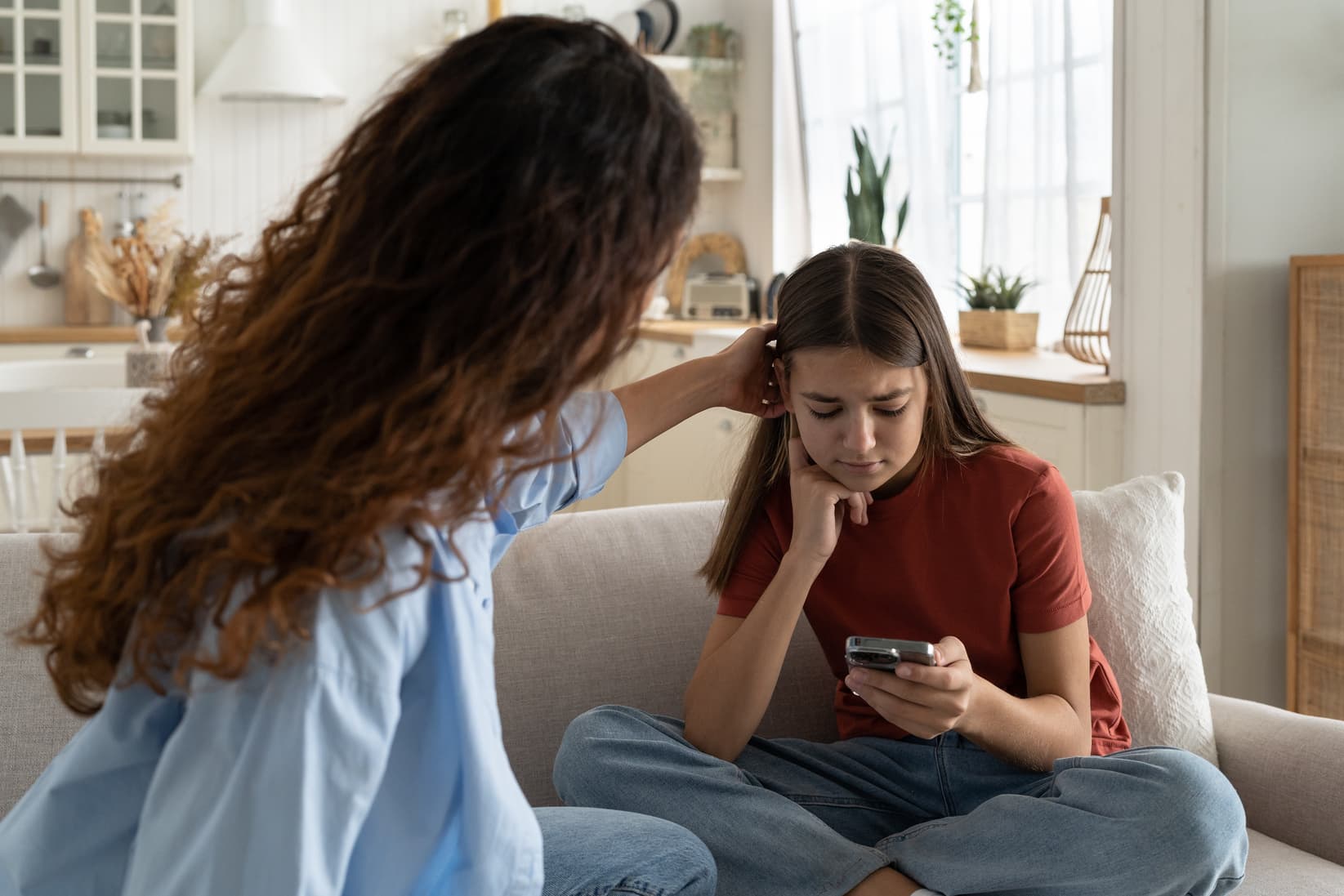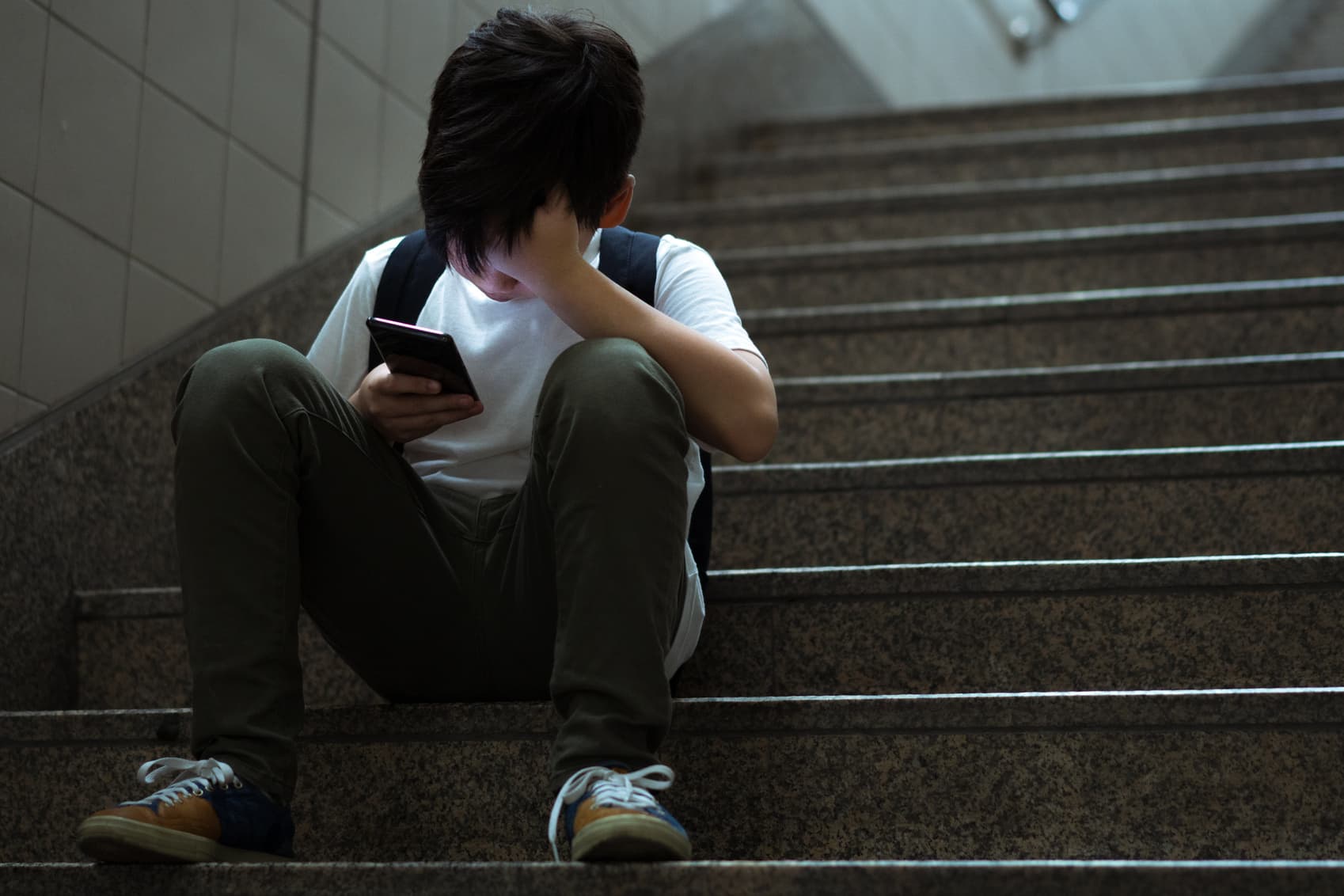
7 signs that could mean your child is being bullied (and what to do about it)

By Brightline team, Aug 12, 2024
Has your child ever been a victim of cyberbullying? Before you say no, consider that almost 50% of kids ages 13–17 say they’ve been a target. And that 20% of tweens ages 9–12 have either seen it, done it, or been a victim of it. Most kids spend plenty of unsupervised time on interactive apps or platforms, and many don’t tell their parents when cyberbullying is happening.
If your child can get online, they’re at risk. And if they happen to use technology as a way to connect with, earn money from, or promote products to an audience, they’re obviously more exposed. Concerned? You’re in good company: nearly three-quarters of parents are worried that their child will be or is being bullied online.
The question now is, what are you going to do about it?
In this article, we’ll discuss:
What cyberbullying is
Cyberbullying examples and where it happens
How common it is, why it’s easy to miss, and the impact
Why your child may not want to tell you
What parents can do and how Brightline can help
So, what is cyberbullying?
Cyberbullying is the use of technology to intentionally harass, threaten, embarrass, or target another person. Repeated online threats and unwanted texts, tweets, posts, images, and private or public messages that are mean, aggressive, or rude all count.
Cyberbullies aren’t just targeting older kids. Yes, the rates of cyberbullying are higher on the popular platforms that older kids (and adults) use the most. But kids are being bullied on gaming platforms, too — even those built to entertain young kids. No matter their age, the more connected to technology kids are, the higher the chance is that they’ll encounter cyberbullying.
Examples of cyberbullying and where it happens
Bullying someone face-to-face takes a certain amount of bravado — the one doing the bullying knows they will be seen and heard by whoever is around. But cyberbullying allows kids to hide behind a screen, a fake persona, or a made-up account name while they do it. Which means it can escalate quickly.
Cyberbullying happens on any online platform that allows community engagement, comments, live streaming, and/or the ability to send public or private messages. This includes apps like Instagram/Facebook, Snapchat, TikTok, YouTube, Twitter/X, Discord, WhatsApp, Twitch, and basic text messaging from anyone who has your child’s phone number.
A few examples of cyberbullying:
Screenshotting, altering, and sharing posts, images, or photos with the intent of humiliating or hurting someone
Threatening, offensive, or false rumors about someone posted either publicly or privately
Sending explicit images that weren’t asked for or sharing private, explicit images publicly without consent
Harassment based on physical appearance, race, ethnicity, religion, physical or mental ability, or sexual identity
Repeated insults, threats, or encouraging suicidal ideation or action
Hate speech, messages, or posts about homophobia, racism, or sexism (cyberbullying on this level is actually against the law in many states)
How common it is, why it’s easy to miss, and the impact
In a 2023 poll done by PEW Research, close to 55% of teens admit that online harassment and bullying are a major concern for kids between the ages of 13–17. The most common types of cyberbullying are offensive name-calling, spreading false rumors, receiving explicit images, constant monitoring (this especially affects older teen girls), physical threats, or having explicit images of themselves shared without consent.
Online bullying is silent, which makes it easy to miss. But it can also be persistent, pervasive, and permanent for the one being bullied and anyone else seeing it. Your child can walk away from their phone or gaming console, but technology doesn’t have an “off” button. That means cyberbullying can happen 24 hours a day, 7 days a week. Depending on the bully’s reach, the photos or messages can be seen by one person or an audience that spreads across the globe.
Cyberbullying can create fear in your child, along with a feeling of instability, physical symptoms like stomach or headaches, and a sense of being out of control. It can wreck their confidence, cause or escalate depression and anxiety, and be a catalyst for a decline in school performance, overall health, and levels of self-worth. The CDC reports that bullying can result in social and emotional distress, self-harm, and even death. On a broader scale, a widespread cyberbullying scheme can also cement a negative online presence, which can have a real impact on college admissions, employment, and more.
Why your child may not want you to know
Parents, teachers, and other adults may not be aware cyberbullying is happening. Many kids of all ages have access to phones without close monitoring — and they don’t always talk about what they see.
Sometimes they don’t share it because they aren’t sure if it’s bullying or not. But if your child is being cyberbullied, they may not want to tell you if they’re:
Worried you’ll respond in a way that will bring even more attention to them
Afraid you’ll take away access to the games, apps, or device altogether
Embarrassed or confused about why it’s happening or what they did to deserve it
Concerned they will be blamed or punished, especially if the bullying is happening on a secret account or an app they aren’t supposed to be using
Worried about big consequences with school or law enforcement
So what should parents or caregivers do? And how can Brightline help?
Okay, so you found out that your child is being cyberbullied. Your protective instincts may have your temperature on the rise — you’re furious and a little scared — and your thoughts are a mashup of: Hug my baby! Call the school! Call the other parent (if you know the child doing it)! Burn the phones! Curse technology!
Take a breath. Yes, it’s upsetting. And yes, you want to keep your child safe, no matter what age they are. So, your first job is to keep the door of communication between you and your child open. Thank them for telling you, or let them know you’re aware and that no matter where it’s happening (or why), this isn’t their fault. Give them the opportunity to share some background or their feelings on the situation. Learn as much as you can. Then, talk about solutions that feel appropriate for them and for you.
What you do can depend on the age of your child, the severity of the cyberbullying, and whether it’s coming from a stranger or someone your child knows personally. Here are some possible options:
Walk away. Sometimes, enforcing putting space between your child and the hurtful actions from a bully can be helpful. Talk with them about taking a break from the device, app, or platform. They may resist (it can feel like they’re losing a privilege because of someone else’s actions), but it can give them time to let the sting wear off and offer some perspective (being online and waiting for comments/messages isn’t everything).
Keep an eye on it, but don’t respond. It can take a lot of willpower to hold back from lashing out. It’s true that sometimes standing up for yourself will make a bully back down, but it could also backfire. Not giving the messages energy may not stop them from coming, but it is a healthy response for your child to learn. If this is your plan, one step of the plan should be to check in regularly with your child and/or review content from certain apps together so that you are making space to not only talk about what’s happening, but so you can revise your plan collaboratively.
Save what you see. Some platforms (like Snapchat) have settings where messages disappear after a certain amount of time. And now, texts can be sent and then unsent. But you or your child can screenshot or print out messages to keep. If you end up having to go to the principal or the police, it can be helpful to have tangible proof that the cyberbullying has been happening, how long it’s gone on, and where it’s coming from.
Report and block. While you can’t control someone else’s activity online, all platforms have protective measures in place that are meant to help curb cyberbullying. Report the person/account to the web page, phone carrier, or app/platform where the bullying is happening. Then, block that person or account. It won’t necessarily stop the activity, but it will restrict access to your child from that account. If they create another account to use, keep proof, then report and block them as well. Depending on the severity of the cyberbullying, you might consider getting law enforcement involved.
Tell another adult. If the cyberbully is someone in your child’s day-to-day world, talk to your child about ways you and other adults can help keep them safe. This might involve the other child’s parents or caregivers, adults at school, or a counselor.
Cyberbullying isn’t a fun subject to cover, but if your kids are on screens (and we know they are), it’s a necessary topic. The kind of unwanted (and unwarranted) attention that cyberbullies bring can feel scary to a child. It can make them — and you — feel nervous, anxious, out of control, and angry. You don’t have to have all the answers, and you don’t have to figure it out by yourself.
Brightline coaches and therapists can help your child build resilience and confidence. And we can help you make a plan that protects your child. Connect with us today to surround your family with the support they need.